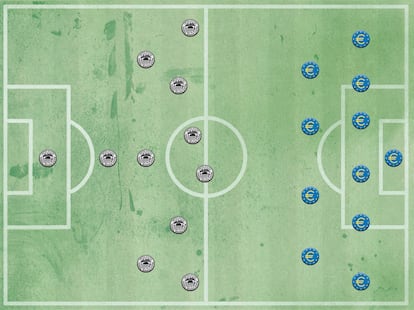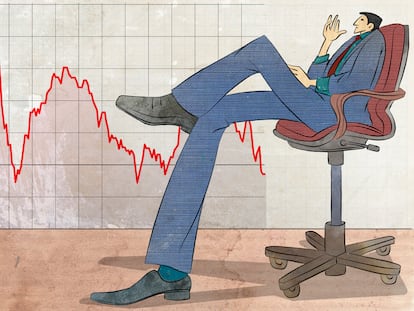The new monetary policy
The US Federal Reserve wants the ball and attack; the European Central Bank for now defends, but let’s hope it does whatever it takes to meet its new mandate

Success in competitive activities depends on having conviction in the objective, flexibility in the strategy, and tactical options to develop it. In soccer, Spain’s Luis Enrique put together a team to dominate the ball that could play in many different ways, with or without wingers, forwards, or fullbacks, but always playing from the back connecting infinite triangles. Italy’s Mancini put together a team that also wanted the ball but when Spain took it away from them, he changed the shape and defended, betting on the penalty kicks. In monetary policy, conviction, flexibility and optionality are also the keys to success. But it has not always been this way. In the old monetary policy, central banks were rigid, they limited themselves to a single instrument, the interest rate, they did not communicate their intentions. In the new monetary policy, everything has changed.
In a volume just published jointly by the Center for Economic and Policy Research in London and the International Center for Monetary and Banking Studies in Geneva, and which I have co-edited with Bill English of Yale University and Kristin Forbes of the Massachusetts Institute of Technology, we gather the actions of sixteen central banks, both from developed and emerging countries, during the Covid crisis, and analyze the similarities, differences, and lessons learned.
The outbreak of Covid in early 2020 caught many central banks still scrambling to raise inflation after a decade below target. The abruptness and speed of the economic downturn, rapidly increasing market volatility, and blinding uncertainty about the impact of the pandemic in an environment of excessively low inflation, prompted an unprecedented reaction from central banks. This was not a standard recession, brought on by overheating or financial excesses, it was similar to an induced economic coma. A different recession required a different response.
In the old monetary policy, central banks were rigid, they limited themselves to a single instrument, the interest rate, they did not communicate their intentions. In the new monetary policy, everything has changed
Short-term interest rates, which were already low in most advanced economies, fell rapidly around the world, reaching zero in all advanced economies and even in some emerging economies. Although there was agreement that fiscal and health policy would play a major role in fighting the pandemic and generating the economic recovery, monetary policy had a critical role to play when markets seized up, capital flows to emerging markets collapsed, and economic activity vanished overnight. Central banks quickly recovered the credit and liquidity strategies, instruments, and facilities that had been used during the 2007 financial crisis, to then expand them and introduce a new panoply of programs to support additional segments of the economy.
Although the specific actions of each central bank were logically determined by the individual needs of their economies and the characteristics of their institutions, several patterns of behavior common to all of them can be discerned: the size, speed and scope of responses; the use of a multidimensional set of instruments (including interest rate cuts and forward guidance, purchases of a wide variety of assets, liquidity and credit lines, and regulatory flexibility); and the ability of emerging markets to use monetary policy countercyclically and behave in a similar way to advanced economies.
This multidimensional response has resolved some outstanding dilemmas. It has ended once and for all the harmful and artificial distinction between conventional and unconventional monetary instruments. The flexibility and optionality provided by this wide range of instruments increases the effectiveness of monetary policy, and all instruments must be available at all times. It has cured fears about the possible inflationary impact of large central bank balance sheets, or of commitments to maintain zero interest rates for as long as is necessary. It has shown that the distinction between developed and emerging economies is not about the instruments available, but about having solid economic fundamentals and a credible institutional framework. Some countries chose not to make asset purchases (even after obtaining the legal authority to do so), and others were only able to use these instruments to a very limited extent.
This new monetary policy also faces several unanswered questions. Interest rates are currently zero in all developed economies, and in some of them they have been for more than a decade. The aggressive and effective response of central banks to the Covid shock shows that they are capable of effectively defending themselves against such a negative surprise. But it is not yet clear that they are capable of attacking with the same intensity and determination. Core inflation has been below target for too long (please ignore the temporary volatility of inflation generated by the reopening) and raising it requires nerves of steel: the only way to convince the world that 2% inflation is really a symmetric objective, and not a ceiling, is to generate a period of inflation above 2%. This makes central bankers uneasy – what if they overdo it and inflation reaches 3%? But it is a necessary risk, because the alternative – structurally low inflation – is worse, as it limits the ability of economic policy to manage the business cycle and dampens future economic growth.
Responding to this need to attack low inflation, both the US Federal Reserve and the European Central Bank (ECB) have revised their monetary policy strategy with a similar objective (reinforce the credibility and symmetry of their target) but a fundamental difference. The Federal Reserve, facing a small inflation deficit, has committed to actively generating a period of inflation above 2%. The ECB, facing a large inflation deficit, has suggested that it might passively tolerate a period of inflation above 2%. The Fed wants the ball and attack, the ECB for now defends. Let’s hope the ECB decides to attack when it implements its new strategy, and does whatever it takes to meet its new mandate.
Twitter: @angelubide
Tu suscripción se está usando en otro dispositivo
¿Quieres añadir otro usuario a tu suscripción?
Si continúas leyendo en este dispositivo, no se podrá leer en el otro.
FlechaTu suscripción se está usando en otro dispositivo y solo puedes acceder a EL PAÍS desde un dispositivo a la vez.
Si quieres compartir tu cuenta, cambia tu suscripción a la modalidad Premium, así podrás añadir otro usuario. Cada uno accederá con su propia cuenta de email, lo que os permitirá personalizar vuestra experiencia en EL PAÍS.
¿Tienes una suscripción de empresa? Accede aquí para contratar más cuentas.
En el caso de no saber quién está usando tu cuenta, te recomendamos cambiar tu contraseña aquí.
Si decides continuar compartiendo tu cuenta, este mensaje se mostrará en tu dispositivo y en el de la otra persona que está usando tu cuenta de forma indefinida, afectando a tu experiencia de lectura. Puedes consultar aquí los términos y condiciones de la suscripción digital.
More information
Últimas noticias
Maduro pleads not guilty before the federal court in New York: ‘I am still the president of Venezuela’
A new test can detect Alzheimer’s from a finger prick
UN team enters Sudanese city of El Fasher after paramilitary massacre: ‘It’s like a ghost town’
A recipe for resistance: Indigenous peoples politicize their struggles from the kitchen
Most viewed
- Gilles Lipovetsky: ‘If you want to live better and fall in love, take Prozac, don’t look to philosophy’
- Alain Aspect, Nobel laureate in physics: ‘Einstein was so smart that he would have had to recognize quantum entanglement’
- Alvin Hellerstein, a 92-year-old judge appointed by Bill Clinton, to preside over Maduro’s trial in New York
- Maduro’s downfall puts China’s relationship with Venezuela to the test
- Why oil has been at the center of Venezuela-US conflicts for decades










































